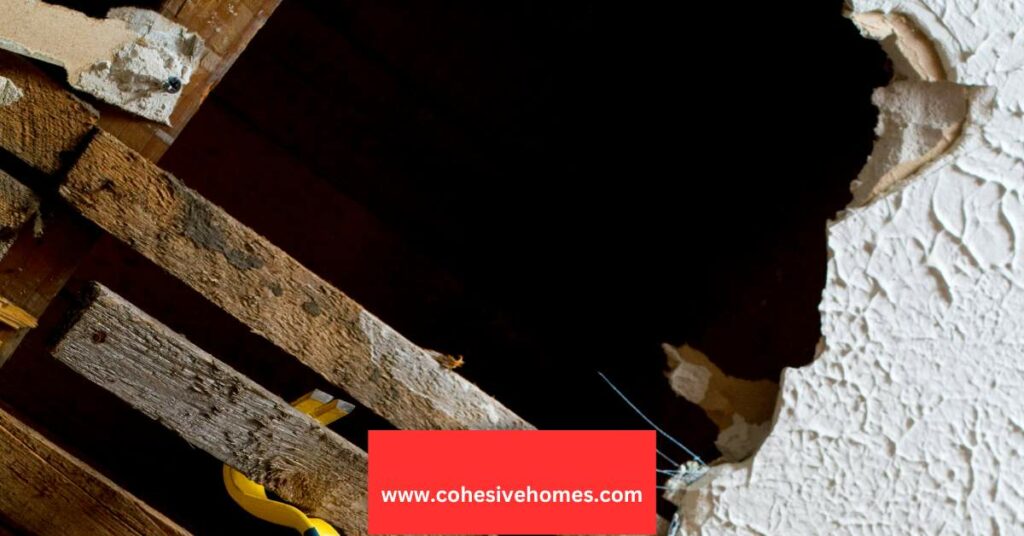
Do you need to cut a hole in your lath and plaster ceiling but have no idea how to go about it? Don’t worry, you’ve come to the right place! Cutting holes in lath and plaster ceilings can be tricky, especially if you don’t know what you’re doing.
But with the right tools and a few precautions, cutting holes in your ceiling can be surprisingly simple.
In this article, I’ll walk you through the whole process from start to finish so you can create the perfect hole in your lath and plaster ceiling without any mess or hassle.
We’ll cover the materials you’ll need, safety tips, and step-by-step instructions on how to do it correctly.
By the end of this article, you’ll be an expert at cutting holes in your lath and plaster ceiling! Let’s get started!
Reasons for Needing to Cut a Hole in the Lath and Plaster Ceiling

If you’re looking to access wiring, pipes, or other hidden elements in your walls or ceiling, then you’ll probably need to cut a hole in it.
The tricky part is that many older homes have lath and plaster walls and ceilings, which are harder to work with than drywall.
Fortunately, with the right tools and safety gear, you can easily cut through lath and plaster.
But before we get into the how-to of it all, it’s important to understand why you might need to cut through this material in the first place.
There are a few common reasons why:
- Installing new lighting fixtures
- Running additional wiring
- Cutting out old rotted ceiling material
- Replacing insulation around pipes or wires
- Accessing plumbing or electric elements behind walls or ceiling surfaces
No matter what your intended project is, know that cutting into lath and plaster is possible, and the end result will be worth it!
Preparing the Area to Be Cut

After obtaining your measurements and marking the wall, you should prepare for the next step.
Start by turning off the electricity to the area in which you’ll be working, just to be safe.
Then, use a utility knife around your marked area to cut through the plaster.
This will create a nice, clean line for you to follow when cutting your hole.
Next, use a handsaw or a reciprocating saw to cut along the line that you created with your utility knife.
You may want to use a piece of plywood underneath the area where you are cutting for added support, as lath and plaster can crumble with intense force or vibration.
While cutting through the lath and plaster, be sure to go slow and steady; you don’t want to crack or damage anything!
Once you have finished cutting, remove any remaining chunks of lath and plaster from around your hole so that it is smooth and even.
To finish up the job, wipe away any excess dust using a damp cloth before handing over the job to an electrician if needed.
Choosing the Best Tools to Use

When it comes to cutting a hole in lath and plaster ceilings, the right tools for the job can make all the difference.
When starting out, you should consider some of the top tools.
Compound Miter Saw
For making precise cuts, you can’t go wrong with a compound miter saw. This power tool is ideal for cutting accurately sized holes in lath and plaster ceilings because it provides a level surface for your saw blade to sit on as you work.
Circular Saw
Circular saws are another great option for cutting into lath and plaster ceilings, especially if your hole size isn’t very large.
Make sure that your circular saw has a dust collection port to help keep your workspace clean as you work.
Power Drill and Hole Saw Attachment
If you need to cut a larger hole than a miter saw or circular saw can handle, then using a power drill combined with a hole saw attachment is the way to go.
You can use a hole saw to cut larger diameter holes quickly and efficiently for any size job you need to complete.
Make sure that the size of the hole you cut is smaller than the width of the lath strip, to avoid weakening the lath too much.
Cutting the Hole in the Lath and Plaster Ceiling

Now it’s time to get down to business and cut the hole in your lath and plaster ceiling. To begin, gather a few tools, such as:
- A drill with a spade bit
- A hammer
- A jigsaw or keyhole saw
- Safety gear (safety glasses, a dust mask, and hearing protection)
Once you have all your gear together, here are the steps to take:
- Before beginning, ensure that you wear your safety gear.
- Drill a hole in the ceiling using the spade bit. This step helps you draw out a rough outline of your hole.
- Using the hammer, gently tap away at any large chunks of plaster that you can easily identify on the ceiling. Don’t use force as it will cause cracks in other parts of the ceiling and walls!
- Insert the blade of your jigsaw or keyhole saw into one edge of the hole outline that you previously drew and slowly cut out the area around it; pay attention not to overdo it just in case you need to patch up some areas!
- When finished cutting, remove any loose pieces from inside your newly created gap from lath and plaster by vacuuming them away. Be careful not to remove too much since this can weaken any surrounding areas!
With these steps in mind, you should now have successfully cut out a safe and secure gap for whatever project needs attention on that part of the lath and plaster ceiling!
Dealing With the Debris From Cutting the Hole

Once you’ve cut the hole in your lath and plaster ceiling, you need to deal with the mess that was made.
Cleaning up the debris is an important part of the process and something you should take seriously.
Here are some tips to ensure that you remove all of the debris:
- Use a Shop-Vac to suck up all of the dust and small pieces of plaster that have been created by cutting through the lath and plaster ceiling.
- Use a broom and dustpan to sweep up any remaining debris from around the hole in your ceiling.
- Vacuum any remaining pieces of dust or debris from the floor around your work area, as this will help keep your home free from potential health hazards.
- Wear a dust mask to protect yourself from any particles that may still be floating in the air after cleaning up your mess.
- Dispose of any material safely, and properly recycle any plastics or metals that may be included with your lath and plaster materials.
Finishing Off and Ensuring Safety

Cutting a hole in lath and plaster is a delicate operation, so it’s important to take safety measures to ensure that the job is done safely and securely. Here are a few things you can do:
Wear Protective Gear
When cutting lath and plaster, you should always wear protective gear like eye protection, gloves, a dust mask, and long sleeves.
This will help protect you from flying debris when cutting the lath and plaster, as well as any toxic particles that may be released.
Secure the Ceiling
It’s also important to secure the ceiling before drilling into it. This includes removing any hanging light fixtures or wires, bracing the area around the hole with wood planks (to prevent anything from falling through), and covering the floor beneath with plastic sheeting or a dust sheet.
Finally, ensure that you’re using a sharp drill bit that won’t get stuck in the lath and plaster.
Once everything is organized and in place, start drilling slowly and steadily. You should work your way around the perimeter of the hole to make sure it is accurately sized for whatever object needs to fit through it. Then clean up any debris from the floor before moving on to patching up the ceiling.
Conclusion

To master the art of cutting a hole in lath and plaster walls and ceilings, the most important thing is having the right tools and taking the necessary safety precautions. With the right knowledge and know-how, you can confidently tackle the task ahead, either on your own or with a team.
Cutting a hole in a lath and plaster wall or ceiling doesn’t have to be an intimidating task, so long as you take the necessary steps to ensure that you’re cutting safely. The results can be spectacular if you take the necessary time to measure and plan accurately, as well as equipping yourself with the tools and skill set to achieve the best outcome.
FAQS
What tools do I need to cut a hole in a lath and plaster ceiling?
Tools needed: drill, saw, knife, tape, pencil, ladder, goggles, and a dust mask.
How do I locate the ceiling joists before cutting the hole?
Locate ceiling joists with a stud finder or by tapping; mark with a pencil before cutting the hole.
How do I cut the hole in the ceiling without damaging the surrounding plaster?
Drill a small hole in the center, use a saw to carefully cut around the edge, score the plaster with a knife to prevent cracking, remove loose plaster, and clean up debris.
